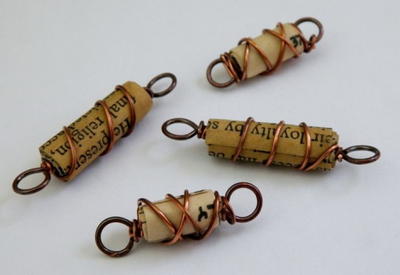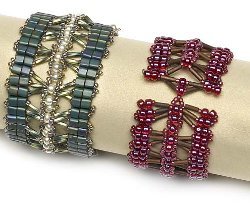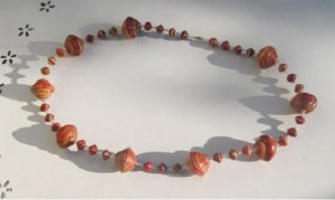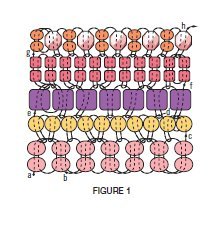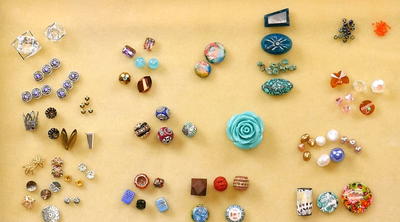Byzantine Beaded Chain Maille Bracelet
The Byzantine Beaded Chain Maille Bracelet from Bead&Button Magazine is a truly Classic accessory for the trendy fanshionista. This beaded bracelet pattern is styles after the shining chain maille worn in the empire of Alexander the Great. Learn how to make beaded bracelets like this by checking out this impressive pattern.
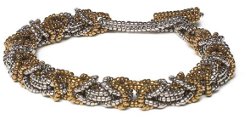
Materials:
- 15/0 seed beads
- 5 g color A (metallic light bronze)
- 5 g color B (nickel plated silver)
- nylon beading thread, size D, to
- match seed beads
- beading needles, #13
- craft glue (optional)
- toothpick
- twist tie
Instructions:
For a bracelet 7¾ in. (19.7 cm)
BRACELET
- On 12 in. (30 cm) of thread, center 17 color A 15/0 seed beads, and tie the beads into a ring with a square knot. Do not pull the thread too tightly or the ring will be distorted.
- Thread a needle on the tail, and sew back through eight 15/0s. With the other needle, sew through nine 15/0s in the opposite direction. Tie a square knot where the two threads meet. With each needle, sew through three 15/0s, and trim the threads. You may choose to secure the ends with a drop of glue.
- Repeat steps 1 and 2 to make 24 color A rings and 20 color B rings.
- On 12 in. (30 cm) of thread, pick up 17 B 15/0s, and pass the strand through four A rings (photo a). Tie the beads into a ring with a square knot. Repeat step 2.
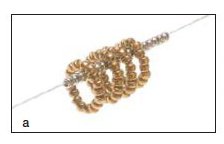
- Repeat step 4 to form a second B ring, passing the new strand through the same four A rings. Position the rings in a 2+2+2 chain. Insert a twist tie through two end rings (photo b).
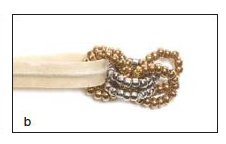
- Holding the end of the chain with the twist tie, flip the opposite end rings back, placing one on each side of the rings in the twist tie (photo c).
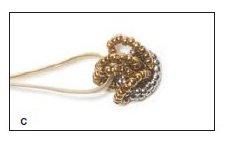
- Spread the rings that are parallel to your work surface, and insert a toothpick through the flipped rings (photo d).
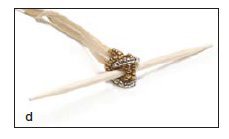
- On 12 in. (30 cm) of thread, pick up 17 Bs, and pass through the space created by the toothpick. Remove the toothpick after passing the needle through this opening (photo e). Attach two A rings (photo f). Tie the beads into a ring with a square knot. Repeat step 2.
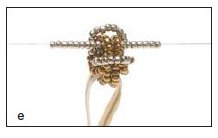
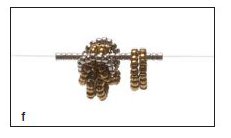
- On 12 in. (30 cm) of thread, pick up 17 Bs to add a second B ring next to the one added in the previous step (photo g). Repeat step 2.
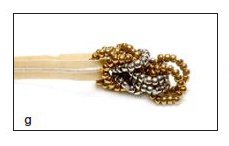
- On 12 in. (30 cm) of thread, pick up 17 Bs, and pass through the two end rings. Tie the beads into a ring with a square knot. Repeat step 2.
- Repeat step 10 to add a second B ring next to the one added in the previous step (photo h).
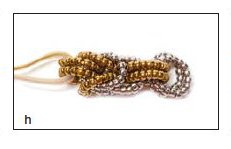
- Repeat steps 6 and 7. Note that the placement of these rings mirrors the placement of the existing rings (photo i). This completes the first Byzantine cluster.
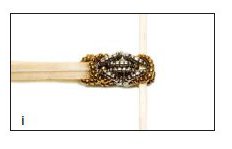
- For the remaining length of the beaded chain maille section, repeat steps 8–12 twice to form each Byzantine cluster, but change the color of the beads picked up for each repeat. Make a total of 10 Byzantine clusters. End the 10th cluster after step 11.
TOGGLE LOOP
- On 1 yd. (.9 m) of thread, pick up two Bs, leaving a 6-in. (15 cm) tail. Sew through the Bs again to place the beads side by side. Continue working in ladder stitch to make a ladder that is four beads long. Sew through the first and last bead to form a ring.
- Working in tubular herringbone, complete four herringbone rounds to form the shank.
- Continue in flat herringbone using two beads on one side, and stitch 22 more rows. Connect the two-bead band to the four-bead shank, sewing through the shank to exit the bottom round.
- Working off one pair of Bs in the bottom round, stitch 15 two-bead rows to make a band. Slide the band through the end rings of the Byzantine chain,and sew through the shank to secure the thread (photo j). End the working thread and tail.
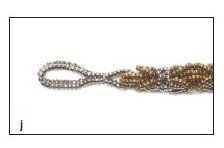
TOGGLE BAR
- On 1 yd. (.9 m) of thread, pick up two As, leaving a 6-in. (15 cm) tail. Sew through the As again to place the beads side by side. Continue working in ladder stitch to make a ladder that is six As long. Sew through the first and last A to form a ring.
- Working in tubular herringbone using As, complete 11 herringbone rounds. Weave through the As of the final round using a ladder stitch thread path to pull the beads into position.
- Sew through the hollow center of the tube. Pick up 12 Bs, and slide them into the tube (photo k). Sew through a column of As.
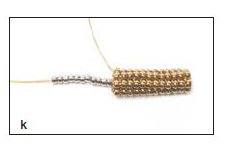
- Pick up a B, and sew through the column of beads opposite from where your thread exited at the start of this step (photo l). Repeat at the other end of the bar. Zigzag through all of the columns to reinforce the toggle bar. Exit the seventh A of any column.
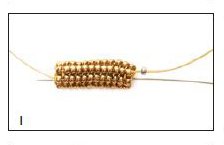
- Pick up two Bs, and sew through the sixth and seventh beads in the column from the previous step (photo m).
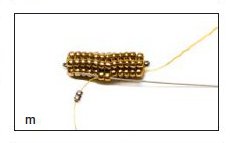
- Sew through the sixth and seventh beads in an adjacent column. Pick up two Bs, and sew through the beads just exited (photo n).
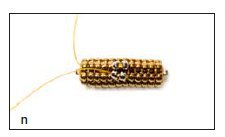
- Sew through the four 15/0s picked up in steps 5 and 6. Sew through the first 15/0 again.
- Working in tubular herringbone stitch, stitch five rounds of Bs to form the shank (photo o).
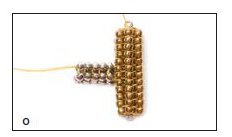
- Working off one pair in the shank, stitch 15 two-bead rows. Slide the band through the rings on the other end of the Byzantine chain, and sew through the shank to secure the thread. End the working thread and tail.
Read Next101+ Free Beading Patterns
Your Recently Viewed Projects
EditorLP
Sep 15, 2016
This pattern is incredibly cool. I really want to try making it soon, though I admit I am a little intimidated!
kajyra 2019970
Apr 29, 2013
Awesome directions and it was very easy to make once I got the hang of it - will post links to pics tomorrow. Thanks much!
octopus
Apr 15, 2012
Excellent...I love the idea of using toothpicks to keep the seed beads separated. This will be my project of the day! Thank you.
Report Inappropriate Comment
Are you sure you would like to report this comment? It will be flagged for our moderators to take action.
Thank you for taking the time to improve the content on our site.


